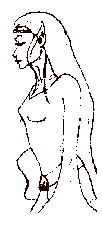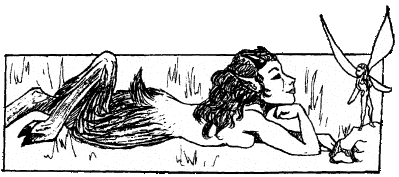 |
FOLKLORIC FICTION
Reviews by Niko Silvester
| Haunting
used bookstores is a favourite pastime of mine. It is especially
therapeutic for the times when I become dissatisfied with the current offerings
on the fantasy shelf in Coles or Smithbooks (take your pick, they are both
owned by the same parent company). Every once in a while, among the
familiar titles I find something I've been wanting to read for ages, or
something I hadn't heard of before. Unfortunately this has been a
rare occurrence lately, something I had put down to moving out of Victoria,
British Columbia (used and antiquarian book capital of Western Canada).
However, I am happy to say that I have had a few good finds in past months,
and they are the focus of this issue's column. Most of these books
are fairly old (compared to other works in the genre, not relative to fiction
in general), but all of them are worth searching out. And just to
show that there are good books on the new fantasy shelf; I will review
the new novel by one of my very favourite authors, Charles deLint. |
 |
Anyone with questions,
comments or suggestions can write to me care of Transmission, or I can
be reached via e-mail at s64ns@morgan.ucs.mun.ca.
John
the Balladeer by Manly Wade Wellman (Baen,
1988)
The copyright date of
this book is deceptive, as it is actually a collection of stories which
range in publication date from 1951 to 1987. John the Balladeer
contains all of Manly Wade Wellman's short stories about his most well
known character, Silver John. John is a wandering musician "who, wandering
through the backwoods of Appalachia, battles supernatural evil with his
silverstrung guitar and the magic of his voice" (so says the dust-jacket
blurb). The stories are written as if narrated by John himself; and
thus contain much of the dialect and speech patterns of Appalachia.
Each story sees John encountering a different folkioric creature or magical
obstacle, which he must overcome by using his own folk magic. Because much
of the prose is written in dialect, I had thought it would be difficult
to read, but when I actually did get into the book, I found that the "speech
patterns" represented in the prose very much enhanced the work. This book
is fiction for folklorists, as well as an essential work for anyone looking
at the uses of folklore in fiction. It may be of special interest
to ballad scholars, partly because of the snippets of ballads found throughout
the book, and partly because WeIlman is supposed to be the writer of the
ballad "Vandy, Vandy". John the Balladeer should not be too difficult
to find in a used bookstore since the Science Fiction Book Club picked
it up as one of their selections not long after it was originally published.
The
Old Gods Awaken by Manly Wade Wellman
(Doubleday, 1979)
Manly Wade WeIlman didn't
begin to write novels about his character, Silver John or John the Balladeer,
until after the bulk of the short stories about that character were published.
The Old Gods Waken is the first novel about John. This book contains
not only folklore drawn from Appalachians of European descent but also
from the Native American peoples of the area. The premise of the
novel is that the actions of two English brothers to "awaken" their own
European Druidic gods are also awakening an evil that was there even before
the first native inhabitants. Most of the Druid lore in the novel
is based on theories current at the time the novel was written (and thus
outdated today), but the meshing together of several different folklore
traditions makes for an interesting and entertaining read. Like John
the Balladeer, this novel is one I would recommend to any folklorist
(or anyone else, for that matter).
The
Perilous Gard by Elizabeth Marie Pope
(Houghton Mifflin, 1974; Tempo, 1984)
This is a book about
faeries. Not little winged sparkly female humanoids, but thin, mysterious
beings who live in hollow hills. The main character is a young woman
named Kate, banished to a remote castle in the north of England for an
insult to the Queen that she didn't write. She stumbles across strange
goings-on at Elvenwood Hall, also known as the Perilous Gard, and ends
up a captive of the faery Queen. Without giving away too much of
the plot, I can say that the story has recues and escapes, love and friendship,
and faery dances in the wildwood. The idea of what faeries actually
are that is followed in this novel is similar to the theory that the belief
in faeries originated with memories of sharing the land with an earlier
people, but is not quite identical to it and still contains enough magic
to satisfy those who read for a regular dose of enchantment. This
is a lovely book with an interesting take on faery lore. To make
it even better, my copy (the Tempo paperback, published in their "MagicQuest"
series) has a frontispiece by Terri Windling (who is not just an excellent
author and one of the best fantasy editors in the business, but also a
wonderful illustrator).
Queen
of Spells by Dahlov Ipcar (Dell, 1973)
Another book for ballad
lovers, Queen of Spells is a slender volume based on Tam Lin,
and although it is a slim novel (a mere 142 pages in length) it is full
of snatches of ballads and folksongs. It follows the traditional
Tam Lin story fairly closely, but filtered though the author's own viewpoint.
I can't say much more about the book without spoiling the surprises, but
I recommend it highly. It is one of those delightful used bookstore
finds that I had never heard about until I found it jammed on the shelf;
but am very happy to have discovered.
Someplace
to be Flying by Charles deLint (Tor, 1998)
Readers of this column
will probably have figured out by now that I think deLint is by far one
of the best writers in the fantasy genre today. He is also one of
a fairly small number of Canadian authors who have made it big in the US
book market. Most of deLint's past writing has been in the urban
fantasy subgenre, and Someplace to be Flying is no exception ("urban
fantasy," like "urban legend" is a label that doesn't quite fit, but is
commonly used, and most people know what you are talking about when you
use it). The book, like deLint's other works, has a varied cast of
fascinating characters ranging from homeless people, to artists, to record
store owners, who constantly challenge our stereotypes. Shape-changing
is a prominent theme in this novel, as it centres around the "Animal People,"
ancient, almost archetypal, beings who can take on human or animal shape.
Thus Jack is an old Native American man in one shape, and a jackdaw in
the other; the Crow Girls, Zia and Maida, are teenaged punks dressed in
black in their human shape, and crows in their animnal shape; and Ray is
a tall red-headed man in one form, and a fox in the other. The plot
involves the loss of Raven's pot, which can remake the world, and the Cuckoos,
malicious Animal People who find the pot and want to create a world with
no humans and no Corvid (Animal People whose animal forms are birds in
the Corvid family: jays, crows, ravens, magpies and the like). As
the dust jacket blurb states: "Weaving Celtic and Native creation myths
with a modern tale uniquely his own, deLint has created a novel that will
forever alter the way we look at the world around us."

Back
Send comments
or queries to culture@mun.ca.
version 2001
CULTURE & TRADITION |
|


